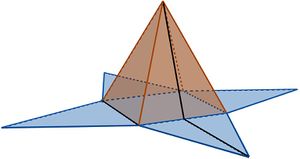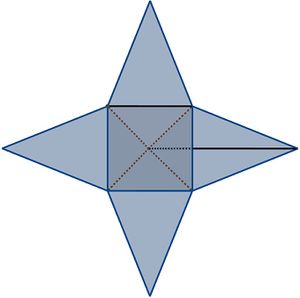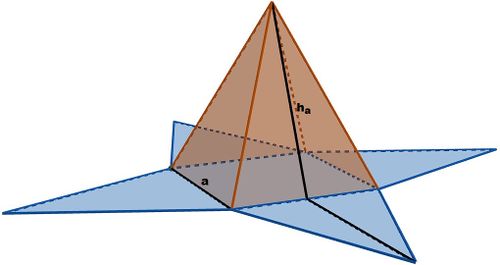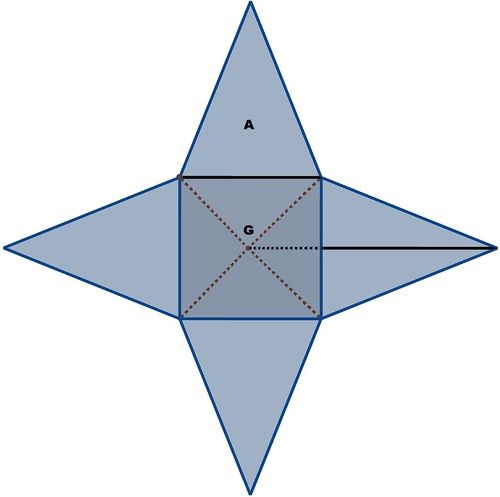Digitale Werkzeuge in der Schule/Pyramiden entdecken/Pyramiden vermessen: Unterschied zwischen den Versionen
Keine Bearbeitungszusammenfassung Markierung: Quelltext-Bearbeitung 2017 |
Keine Bearbeitungszusammenfassung Markierung: Quelltext-Bearbeitung 2017 |
||
| Zeile 136: | Zeile 136: | ||
[[Datei:Pyramide Gitternetz mit Angaben.jpg|rahmenlos|500px|rechts|Gitternetz einer Pyramide mit angegebener Kantenlänge und Seitenhöhe.]] | [[Datei:Pyramide Gitternetz mit Angaben.jpg|rahmenlos|500px|rechts|Gitternetz einer Pyramide mit angegebener Kantenlänge und Seitenhöhe.]] | ||
'''Grundfläche G''': | '''Grundfläche <math>G</math>''': | ||
<math>G = a \cdot a</math> | <math>G = a \cdot a</math> | ||
| Zeile 144: | Zeile 144: | ||
<math>G = 25 \text{ cm}^2</math>. | <math>G = 25 \text{ cm}^2</math>. | ||
'''Seitenfläche A''': | '''Seitenfläche <math>A</math>''': | ||
<math>A = \frac{a\cdot h_a}{2} </math> | <math>A = \frac{a\cdot h_a}{2} </math> | ||
| Zeile 152: | Zeile 152: | ||
<math>A = 15\text{ cm}^2</math> | <math>A = 15\text{ cm}^2</math> | ||
'''Mantelfläche M''': | '''Mantelfläche <math>M</math>''': | ||
<math>M = 4 \cdot A</math> | <math>M = 4 \cdot A</math> | ||
| Zeile 160: | Zeile 160: | ||
<math>M = 60\text{ cm}^2</math>. | <math>M = 60\text{ cm}^2</math>. | ||
''' | '''Oberflächeninhalt <math>O</math>''': | ||
<math>O = G + M</math> | <math>O = G + M</math> | ||
| Zeile 180: | Zeile 180: | ||
{{Lösung versteckt|1= | {{Lösung versteckt|1= | ||
'''a)''' | |||
'''Grundfläche <math>G</math>''': | |||
<math> G = a^2 </math> | <math> G = a^2 </math> | ||
| Zeile 186: | Zeile 188: | ||
<math> G = 6^2 = 36 </math> | <math> G = 6^2 = 36 </math> | ||
'''Seitenfläche <math>A</math>''': | |||
<math> A = \frac{a \cdot h_a}{2} </math> | |||
<math> A = \frac{6 \cdot 7}{2} = 21 </math> | |||
'''Oberflächeninhalt <math>O</math>''': | |||
<math> O = G + 4 \cdot A </math> | |||
<math> O = 36 + 4 \cdot 21 = 120 </math> | |||
'''b)''' | |||
'''Seitenfläche <math>A_a</math>''': | |||
<math> A_a = \frac{a \cdot h_a}{2} </math> | |||
<math> A_a = \frac{8 \cdot 6,71}{2} = 26,84 </math> | |||
'''Seitenfläche <math>A_b</math>''': | |||
<math> A_b = \frac{b \cdot h_b}{2} </math> | |||
<math> A_b = \frac{6 \cdot 7,21}{2} = 21,63 </math> | |||
'''Mantelfläche <math>M</math>''': | |||
<math> M = 2 \cdot A_a + 2 \cdot A_b </math> | |||
<math> M = 2 \cdot 26,84 + 2 \cdot 21,63 = 96,94 </math> | |||
'''c)''' | |||
'''Grundfläche <math>G</math>''': | |||
<math> G = a \cdot b </math> | |||
<math> G = 6 \cdot 10 = 60 </math> | |||
'''Seitenfläche <math>A_a</math>''': | |||
<math> A_a = \frac{a \cdot h_a}{2} </math> | |||
<math> A_a = \frac{6 \cdot 8,6}{2} = 25,8 </math> | |||
'''Seitenfläche <math>A_b</math>''': | |||
<math> A_b = \frac{b \cdot h_b}{2} </math> | |||
<math> A_b = \frac{10 \cdot 7,62}{2} = 38,1 </math> | |||
'''Mantelfläche <math>M</math>''': | |||
<math> M = 2 \cdot A_a + 2 \cdot A_b </math> | |||
<math> M = 2 \cdot 25,8 + 2 \cdot 38,1 = 127,8 </math> | |||
'''Oberflächeninhalt <math>O</math>''': | |||
<math> O = G + M </math> | |||
<math> O = 60 + 127,8 = 187,8 </math> | |||
'''d)''' | |||
'''Seitenfläche <math>A</math>''': | |||
<math> A = \frac{a \cdot h_a}{2} </math> | |||
<math> A = \frac{2 \cdot 4,72}{2} = 4,72 </math> | |||
'''Mantelfläche <math>M</math>''': | |||
<math> M = 6 \cdot A </math> | |||
<math> M = 6 \cdot 4,72 = 28,32 </math> | |||
|2=Lösungen|3=Lösungen verbergen}} | |2=Lösungen|3=Lösungen verbergen}} | ||
{{Box | Aufgabe 9: Tetraeder? | | {{Box | Aufgabe 9: Tetraeder? | | ||
Version vom 27. November 2022, 16:52 Uhr
Wiederholung
Rechteckigen Flächeninhalt berechnen
Dreieckigen Flächeninhalt berechnen
Oberflächeninhalte berechnen
Wie du bereits im vorherigen Kapitel entdeckt hast, lässt sich die Oberfläche einer Pyramide in ein Netz überführen, indem man die Pyramide aufklappt und die Seitenflächen auf eine Ebene faltet.
Das so entstandene Netz besteht somit aus einer Grundfläche und den dreieckigen Seitenflächen, welche zusammen die sogenannte Mantelfläche bilden.
Den Flächeninhalt des gesamten Netzes nennt man den Oberflächeninhalt . Du kannst dir diese Größe als Menge an Verpackung vorstellen, die du benötigst, um das pyramidenförmige Objekt zu umschließen.
Im Falle einer quadratischen Pyramide, welche ihre Spitze über der Mitte ihrer Grundfläche hat, ergibt sich für die Grundfläche die Fläche eines Quadrates und für ihre Mantelfläche die Flächeninhalte von vier gleich großen Dreiecken.
a)
Grundfläche :
Seitenfläche :
Oberflächeninhalt :
b)
Seitenfläche :
Seitenfläche :
Mantelfläche :
c)
Grundfläche :
Seitenfläche :
Seitenfläche :
Mantelfläche :
Oberflächeninhalt :
d)
Seitenfläche :
Mantelfläche :
Pyramiden schätzen
Vertiefen und Vernetzen













